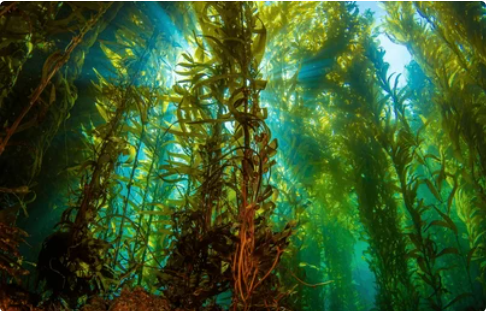Seaweed: an important new product with high demand
Seaweeds are fascinating and diverse organisms, often overlooked as simple marine plants. They are not plants in the traditional sense but rather belong to a separate kingdom called Protista. Seaweeds are vital in the marine ecosystem, growing marine and shallow coastal waters and rocky shores. Marine algae produces up to 50 to 80% of the world’s oxygen and absorbs large amounts of carbon dioxide. They serve as primary producers, forming the base of the food chain for countless marine animals. They also provide shelter and nursery grounds for various creatures, and their decomposition releases vital nutrients back into the water column. Seaweeds are often termed wonder herbs/plants because of their potential in multiple industries like Agriculture, Food, and Processing and their use in the pharmaceutical industry, bio-medical, and personal care; they are also termed the medical food of the 21st century. Many nutraceutical products are developed by the ICAR-Central Institute of Fisheries Technology (CIFT). With its expertise in post-harvest processing and value addition, Kochi has developed several seaweed-based products with anti-inflammatory, anti-diabetic, anti-cancer, and immune-modulating properties, seaweed cookies, Nutri-drink, etc.. has also been developed. An alternative to plastic has also been developed in the form of seaweed sachets and packing material, which can further become a revolution in protecting the environment.
What is seaweed and its most known types?
Seaweed belongs to the kingdom Protista, which encompasses a vast array of single-celled and multicellular organisms, and seaweeds occupy a unique niche within it. Unlike land plants, seaweeds lack roots, stems, and leaves. Instead, they have evolved specialized structures called holdfasts, stipes, and blades to anchor themselves, conduct nutrients, and capture sunlight. These structures vary greatly depending on the type of seaweed, contributing to their incredible diversity in shapes, sizes, and textures. It’s important to remember that “seaweed” is not a taxonomic term but rather an ecological grouping for marine algae. Different seaweed types belong to various Protista sub-kingdoms:
- Rhodophyta (Red algae)
- Chlorophyta (Green algae)
- Ochrophyta (Brown algae)
- Cyanophyta (Blue-green algae) (sometimes considered a separate kingdom)
The commercially exploited seaweed species in India mainly include Gracilaria edulis, Gelidiella acerosa, Kappaphycus alvarezii, Sargassum spp., and Turbinaria spp.
Is seaweed farming profitable in India?
India, known for its rich agricultural heritage, also has an extensive coastal line covering the mainland coastline of 5,422.6 km, encompassing the peninsula’s eastern, western, and southern coasts. The island coastline is 2,094 km, which is contributed by the Andaman and Nicobar Islands in the Bay of Bengal and Lakshadweep Islands in the Arabian Sea. The demand for seaweed and its products is increasing at 10% per annum. And it’s a 19 billion Dollars industry. There are more than Eight hundred forty identified species of seaweeds, out of which 51% are Red algae, 26% are Green algae, and the remaining are Brown algae.
These marine macroflora are gaining immense attention in nutraceutical industries due to their protective function against chronic diseases. Indian nutraceuticals market has been growing at the compound annual growth rate of 20 percent for the past three years, particularly in functional food products, antioxidants, and immunity boosters.
These developments point towards the fast proliferation of the specific segments of nutraceuticals in India and its acceptance by Indian consumers and healthcare providers. With increasing health awareness and the shift towards preventive health care, India’s future in this segment is promising. Recent efforts by the government to bring about clarity in regulatory protocols about nutraceutical products have also augmented the rapid growth of this segment.
In 2022, the global seaweed production was close to 35MT, worth around 16.5 Billion dollars. Still, India has a display of 34,000 T. Considering all this, the Indian government has created a package of Rs. 640 crores to promote seaweed cultivation up to 1.12 MT by 2025.
Seaweed farmers in India are mostly small-scale farmers, so there is a need to encourage them to cultivate seaweed, which can increase their income and profit.
What are the schemes in place to encourage seaweed cultivation?
Pradhan Mantri Matsya Sampada Yojana (PMMSY): This flagship scheme, launched in 2020, aims to revolutionize the fisheries sector with a focus on increasing aquaculture, including seaweed farming. It provides seaweed farmers financial assistance, training, technology transfer, and market linkages.
Blue Revolution: The Department of Fisheries initiative aims to enhance production through area expansion, capacity building, and market development. It focuses on providing farmers with essential infrastructure like drying yards, processing units, and access to quality planting material.
National Fisheries Development Board (NFDB): This agency offers various financial and technical support programs for cultivation. These include subsidies for farms, training programs for farmers, and research and development initiatives for improved production and processing techniques.
Multipurpose Seaweed Parks: These dedicated parks, like the one recently established in Tamil Nadu, provide a centralized platform for cultivation, processing, and value addition. They offer farmers shared infrastructure, technological expertise, and collective marketing opportunities.
State-specific schemes: Several coastal states in India, like Tamil Nadu, Andhra Pradesh, Gujarat, and Kerala, have their cultivation programs. These schemes offer financial incentives, technical guidance, and market connections tailored to the local context and seaweed varieties.
References:
BOOK – ICAR Technologies: High-Value Nutraceutical and Nutritional Products from Seaweeds Editors: A. Gopalakrishnan, C. N. Ravishankar, Pravin, J.K. Jena










































































